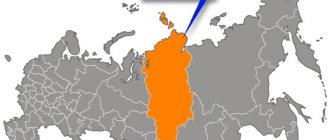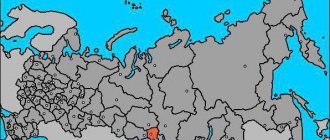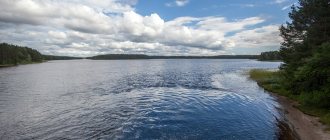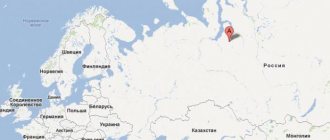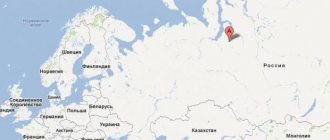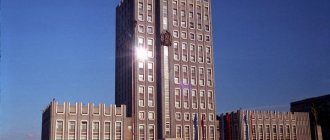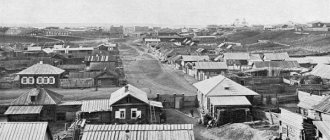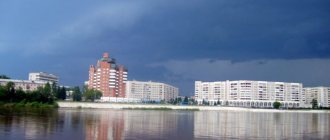Founded: 1628
The Chapel of Paraskeva Pyatnitsa is depicted on the 10-ruble banknote of Russia
Krasnoyarsk
- Russian city, the capital of the Krasnoyarsk Territory, located on both banks of the Yenisei.
The city was founded
in 1628 in the area between the Kacha and Yenisei rivers as a military fortification. The fort that was built was called Krasny, later Krasny Yar. Krasnoyarsk received city status in 1690.
Since 1822, Krasnoyarsk has been the center of the Yenisei province. In tsarist times, Krasnoyarsk was one of the places of political exile. Eight Decembrists were exiled to Krasnoyarsk. On March 28, 1899, a railway bridge across the Yenisei was built. In 1900, an exact model of this bridge was exhibited at the World Exhibition in Paris, where, along with the Eiffel Tower, the bridge received the GRAND PRIX and a gold medal.
Soviet power in the city was established on January 4, 1920. Under Soviet rule there was a sharp growth in industry. During the Great Patriotic War, many enterprises were evacuated to the city, and new industrial giants were built. There are about 15 large hospitals in the city. The Alaska-Siberia highway passes through Krasnoyarsk, along which aircraft from the United States and Siberian aircraft factories are ferried.
Bridge over the Yenisei In the post-war years, the development of industry and science continued. In the 1960s, construction of the Krasnoyarsk Akademgorodok began. In 1995, construction of the metro began. The estimated launch date for the first section of the first line is 2014. Modern Krasnoyarsk continues its active development.
In 2000, the Roev Ruchey Zoo opened, one of the largest zoos in Russia.
By decree of the President of the Russian Federation dated May 20, 2022, the city was awarded the title “City of Labor Valor.”
Krasnoyarsk “Pillars”
It’s best to start getting acquainted with Krasnoyarsk It is worth taking a trip across the Communal Bridge, which is about 2 km long. Dubrovinsky Street - the Yenisei embankment, Karaulnaya Mountain, Intercession Cathedral, and Trinity Church - attract attention. Near Krasnoyarsk there is the famous Stolby nature reserve.
Interesting fact
(1) March 13, 1807 - in Krasnoyarsk, on the way to St. Petersburg, Count Nikolai Rezanov, the prototype of the hero of the rock opera “Juno and Avos,” dies.
Chapel of Paraskeva
depicted on the 10-ruble Russian banknote.
Lives in the city
more than a million people (as of 2022).
Day of the city
Krasnoyarsk celebrates in June.
Krasnoyarsk (Russia): general information about the city
This is one of the largest cities in the Asian part of the country, an important industrial, cultural and educational center of Siberia. Today, about one and a half million people live in the Krasnoyarsk agglomeration. Thus, it is the easternmost millionaire city in Russia. The total area of Krasnoyarsk is 354 square kilometers.
Krasnoyarsk was founded back in 1628 as a fort, the purpose of which was to protect Russian lands from raids by nomads. The city's name comes from the brownish color of the local rocks, which are of volcanic origin.
Modern Krasnoyarsk is called the economic capital of all Eastern Siberia. The metallurgical, chemical, woodworking and space industries are quite developed here. Hydropower and mechanical engineering enterprises operate in the city. Krasnoyarsk, among other things, is the most important educational center in Siberia. In total, over 150 thousand students live and study in the city.
Origin of the city's name
In the earliest documents, the future city of Krasnoyarsk bore the name of the New Kachinsky fort; this name was given by the Kache River, the left tributary of the Yenisei, where it was located. This gave rise to the assumption that the Kachinsky fort existed before him. Most likely, it was founded as a tribute collection point or it was just a winter hut; the estimated date of the founding of Krasnoyarsk, taking these circumstances into account, is 1608.
The local Kachin people called this place Khyzyl Char, which translated into Russian meant Red Yar (shore, cliff). In Russian, the word “red” meant beautiful. Indeed, the place that was chosen for the prison had enchanting Siberian beauty. After the settlement was given the status of a city, it began to be called Krasnoyarsk.
The city of Krasnoyarsk - what part of Russia?
The Krasnoyarsk Territory occupies a middle place on the map of the country. It is practically equidistant from both the eastern and western borders of modern Russia. This is one of the largest subjects of the Russian Federation, occupying almost 14% of its total territory. The Krasnoyarsk Territory stretches from the shores of the Arctic Ocean in the north almost to the very border with Mongolia in the south.
What part of Russia is Krasnoyarsk? The city is located in the southern part of the Krasnoyarsk Territory, in a basin formed by the spurs of the Sayan Mountains. The Yenisei divides it into two parts of almost the same size. The two banks of the river within the city are connected by six bridges.
Below are the exact geographic coordinates of Krasnoyarsk (in ordinary and decimal degrees):
| City coordinates | in degrees: | in decimal degrees: |
| Latitude | 56° 00′ 43" north. latitude | 56.0100632 north. latitude |
| Longitude | 92° 52′ 17" east. longitude | 92.8716125 east. longitude |
In terms of area, Krasnoyarsk is the most compact among millionaire cities in Russia. Its length from north to south is 37 km, and from west to east – 40 km. If you look at the map, you can see with the naked eye that the main axis of the formation of the urban space of Krasnoyarsk was and remains the Yenisei valley.
The city is located within the UTC+7 time zone. The time difference with Moscow is 4 hours.
Distances from Krasnoyarsk to other major cities of the mainland (along highways) are:
- to Moscow – 4160 km;
- to St. Petersburg – 4620 km;
- to Chelyabinsk – 2350 km;
- to Irkutsk – 1060 km;
- to Tokyo – 4160 km;
- to London – 7060 km;
- to Ulaanbaatar – 2060 km;
- to Astana – 1850 km.
Road transport
Two federal and one regional highways pass through Krasnoyarsk:
- Federal highway P255 “Siberia”, connecting Krasnoyarsk with Novosibirsk, Tomsk, Kemerovo and Irkutsk. Formally, the route is a continuation of the P254 Irtysh highway, which goes to Chelyabinsk through Novosibirsk, Omsk and Kurgan. P255 is part of the Asian road route AN6, which connects Eastern Europe (starting at the border with Belarus) and the Republic of Korea, passing through the territory of Kazakhstan, China and the DPRK.
- Federal highway P257 “Yenisei” to Abakan, Kyzyl, Chadan and Khandagaydy, thus connecting Krasnoyarsk with the border of Mongolia.
- Regional highway P409 (04K-044) “Yenisei Highway” to Yeniseisk via Lesosibirsk. The road connects Krasnoyarsk with the federal highways P255 Siberia and P257 Yenisei.
Climate and natural conditions of Krasnoyarsk
The city has a hilly topography and is surrounded by low mountains on almost all sides. One of the districts of Krasnoyarsk (Akademgorodok) is located on the spurs of the Sayan ridge. Not far from it there is a unique natural monument “Pillars”, which is a place of tourist pilgrimage for all residents of the city.
The city is located within the natural forest-steppe zone. The most common tree species here are cedar, pine, birch and larch.
Krasnoyarsk is located in the depths of the Eurasian continent. In this regard, the climate here is sharply continental, with significant temperature amplitudes across the seasons. The average air temperature in January is –20 degrees, and in July – +25 degrees.
From the history of the 18th century
At the beginning of the century, 850 people lived in the city. These were mainly Cossack families. The foundation of Krasnoyarsk and its significance in the development of Siberia are great. Its development was predetermined by the construction of the Siberian Highway, which connected the city with Cannes, Achinsk and further with other cities of the country. Despite the fact that its population increased to two thousand people, it remained a city of district significance.
The city developed, enterprises appeared, in particular the Vasilievsky iron smelting plant, schools and a public library were opened. Great changes have occurred since the founding of Krasnoyarsk. The year 1784 was marked by a strong fire. He burned almost the entire city, leaving only 30 houses. The sergeant surveyor P. Moiseev, who was sent, drew up a new linear layout of the city, using the St. Petersburg layout as a basis. Modern Krasnoyarsk begins with it.
Ecology and city improvement
The environmental situation in the city is far from ideal. The reason for this is numerous industrial enterprises, active mining of ferrous metals, as well as the burial of nuclear waste near the city. Air pollution is one of the primary environmental problems of modern Krasnoyarsk. It is felt most acutely by residents of areas located in lowlands. The atmosphere over Krasnoyarsk is polluted with carbon and nitrogen oxides, dioxides, formaldehydes and other substances.
The worst environmental polluters in the city are the following enterprises: Krasnoyarsk Aluminum JSC, Krasnoyarsk CHPP-1, CHPP-2, as well as a number of coal-fired boiler houses.
As for landscaping, everything is in perfect order in Krasnoyarsk. City streets are clean, well-groomed and very green. It is worth noting that Krasnoyarsk several times became “The Most Comfortable City in Russia.”
Flag
The flag of Krasnoyarsk is made in the form of a rectangular panel. The aspect ratio is 1.5:2.5 units. It consists of four rectangular sections separated by horizontal and vertical golden lines. Their thickness is 0.05 units. The bottom left and top right are azure fields, the rest are red. In the center there is a coat of arms without a crown and holders with a size ratio of 0.75:0.95 units.
The artistic composition was approved by the decision of the Krasnoyarsk City Council dated September 19, 2004 No. 3-37 (as amended on March 27, 2007 No. 13-291). Included in the State Heraldic Register of the Russian Federation under No. 113.
Interesting facts about Krasnoyarsk
Finally, we bring to your attention ten interesting facts about the city of Krasnoyarsk:
- in 1749, the first meteorite in Russia was found in the vicinity of the city;
- one of the largest waste processing plants in the country operates in Krasnoyarsk;
- the real “trick” of Krasnoyarsk is the fountains, of which there are 140 in the city;
- every summer, live palm trees from the local botanical garden are planted on the central streets of the city;
- on the 10-ruble banknote you can see several attractions of Krasnoyarsk, namely the local hydroelectric power station, the Communal Bridge over the Yenisei and the Chapel of Paraskeva Pyatnitsa;
- the first casino of the Soviet Union opened here, this happened in 1924;
- before the start of World War II, many Chinese lived in Krasnoyarsk;
- Krasnoyarsk resident Boris Smirnov was included in the Guinness Book of Records as the person who donated the largest amount of blood (68 liters);
- athletes from Krasnoyarsk became world champions in motorsports 21 times;
- sculptural compositions are another distinctive feature of Krasnoyarsk (the city is decorated with dozens of funny sculptures).
In literature
Elena Yakovich
The daughter of the philosopher Shpet in the film by Elena Yakovich. The full version of the memoirs of Marina Gustavovna Shtorkh (2014) is about Krasnoyarsk in 1935: “Back then Krasnoyarsk was small. Some ten - fifteen minutes - and all of Krasnoyarsk through. From the railway it was easy to walk to the river. And there is a large clearing already on the banks of the Yenisei. Big one! It was the first time I saw such a river.”
Chekhov Anton Pavlovich (1860 - 1904)
"From Siberia"
- “On this shore is Krasnoyarsk, the best and most beautiful of all Siberian cities, and on that there are mountains that reminded me of the Caucasus, just as smoky and dreamy. I stood and thought: what a full, intelligent and courageous life will illuminate these shores in time! I envied Sibiryakov, who, as I read, was sailing from St. Petersburg by boat to the Arctic Ocean in order to get from there to the mouth of the Yenisei; I regretted that the university was opened in Tomsk, and not here in Krasnoyarsk.”
Letter to the CHEKHOVS May 28, 1890 Krasnoyarsk - “Krasnoyarsk is a beautiful, intelligent city; in comparison, Tomsk is a pig in a yarmulke and bad manners. The streets are clean, paved, the houses are large and stone, the churches are elegant.”
Present tense
The post-Soviet era is characterized by a reduction in industrial production and the development of trade and the service sector. Hundreds of shops and supermarkets are being built and operate in the city; here you can buy almost everything, including orthopedic bases. Krasnoyarsk has noticeably changed and become more beautiful. In recent years, new buildings and cultural and entertainment facilities have been built. Hundreds of cafes and restaurants are open.
But this is still a working city. Krasnoyarsk is also a city of students, there are more than 150 thousand of them here, and 124 thousand schoolchildren should be added to them. There are all types of transport in the city: railway, road (routes R 255 "Siberia", M 54 "Yenisei", R 409 "Yenisei Tract"), water, air (airports "Emelyanovo", "Cheremshanka"), metro.
Krasvozduh
Krasnoyarsk Chapel An architectural monument of the 19th century. 07/28/2015
The history of the city of Krasnoyarsk begins on August 6, 1628 . Voivode Andrei Dubensky founded a wooden fort on the spit between the Yenisei and Kacha rivers. The prison was a wooden fortress surrounded by a moat, rampart and walls with 5 towers. A watchtower was erected on top of the nearby Kum Tigey hill Now the hill is called Karaulnaya Mountain. The tower performed a completely practical function. From it, the entire nearby territory visible . When the guard on the tower noticed approaching enemy, they lit a fire. Ostrog seeing the fire, hastily prepared for the siege and not taken by surprise! Perhaps the history of the city of Krasnoyarsk did not stop thanks to this particular watchtower! The Krasnoyarsk fort served the function of protecting the city of Yeniseisk, partly the city of Tomsk, and later attacks by Mongolian and Turkic tribes . In 1805 Chapel was built on the site of the watchtower , which was converted from 1855 . Subsequently, this Chapel became a hallmark in the history of the city of Krasnoyarsk. After the annexation of Siberia to Russia, the Krasnoyarsk fort ceased to have military significance and in the 1690s received the STATUS OF A CITY. Actually, it was from this time the history of Krasnoyarsk as began ! The name of the city “Krasnoyarsk” is formed from two words “red” and “yar”. “Yar” is a high, steep, steep bank that was next to the city at the time of its founding. "Red" because SOIL
this
YARA RED HUE!
Krasnoyarsk Chapel. A cannon fire notifies the city of the onset of noon. 02/07/2013
In 1713, there were about 2,550 living in Krasnoyarsk . The city's inhabitants mainly engaged in agriculture. Until 1773, the city looked like a military fortress. In 1773, fire occurred in the history of the city of Krasnoyarsk and the city had to be built almost anew! After the division of Siberia into Western and Eastern in 1822 was formed . Krasnoyarsk became the center of the Yenisei province. Several squares with churches and markets appeared in the city On the initiative of the first Krasnoyarsk governor A.P. Stepanov, a city garden with naturally growing appeared in the center of the city on the banks of the Yenisei. Today the garden has been renamed the M. Gorky Park.
The next significant stage in the development of the history of the city of Krasnoyarsk was 1884 . This year, the director of the Krasnoyarsk Teachers' Seminary, archaeologist and local historian Ivan Timofeevich Savenkov, opened the first site of an Old Stone Age man on the Yenisei at the foot of Afontovaya Mountain. Now this is the place where the road bridge the left bank of the Yenisei next to the railway bridge. Scrapers, tips , bones of a mammoth, primitive bull, and reindeer were found here . These finds are the only monument of the Paleolithic era in Russia. The man Savenkov discovered was called “Afontovets.”
mining was of great importance in the development of the history of the city of Krasnoyarsk . Gold miners and began to settle in Krasnoyarsk . Capital stone began to be built . The population began to grow rapidly ! In 1838, the first city opened . This library was collected and opened by the Krasnoyarsk merchant, gold miner, homeowner, winemaker Gennady Vasilyevich Yudin. The library contained more than 80,000 books, a huge number of magazines, manuscripts, and archival materials. Yudin, fearing frequent city fires , built a library away from city buildings at the foot of Afontova . Unfortunately, now most of the library is located in the Library of Congress.
On the night of April 17-18, 1881 , a tragic event occurred in the history of the city of Krasnoyarsk - broke out . Within a few hours, 2/3 of the old part of the city burned out! Thousands of residents remained on the street. It was the worst fire since 1773 ! The next fundamental step in the development of the history of the city of Krasnoyarsk was the opening in 1883 of the first elementary school at the expense of the merchant of the 3rd guild M. Sazhin. In the next 10 years, 2 more primary schools were opened ! According to the 1887 census , Krasnoyarsk was the most literate city in Siberia!
In the 1870s 44 lanterns with candle were installed on Voskresenskaya Street, today Mira Avenue . In October 1891, the merchant of the 1st guild N.G. Gadalov the first in the city in his mansion-shop, today the Detsky Mir ! The prospect of electric lighting forced the city authorities to build a power plant. It was built according to the design of Moscow professor K.A. Krug on the banks of the Yenisei opposite Sadovaya Lane. Electric street was turned on in 1912 .
The next strongest impetus in the development of the history of the city of Krasnoyarsk was the passage of the railway through Krasnoyarsk in 1895 From that moment on, the history of the development of the city of Krasnoyarsk began to outstrip the history of the development of the city of Yeniseisk. The fact is that before the advent of the railway, the main life-supporting transport artery of the Yenisei province was the Yenisei River. The city of Yeniseisk, on the Yenisei River, occupies a more advantageous location than Krasnoyarsk. It is located approximately 330 km downstream of the river and, most importantly, Yeniseisk is located BEHIND the so-called Kazachinsky rapids. Therefore, the history of the city of Yeniseisk began 9 years earlier than the history of the city of Krasnoyarsk and developed more actively until the railway passed through Krasnoyarsk
After the appearance of the railway in Krasnoyarsk in 1895, apartment buildings began to be built in . In 1868, the building for a men's gymnasium was built . Today it is the Polytechnic Institute on the street. Lenin. In 1878 building was built . Today it is the Pedagogical Institute on the street. Mira. was built in 1913 . Today it is the House of Officers. In 1914, was built . A great achievement in the history of the city of Krasnoyarsk was the railway bridge across the Yenisei River, which was built in 3 years from 1896 to 1899 . This was the very first bridge across the Yenisei. At the world Paris exhibition of industrial metal structures in 1900 , the Krasnoyarsk railway bridge took 2nd place in the world. Only the Eiffel Tower was ahead of him
At the very beginning of the 20th century, by Siberian standards, Krasnoyarsk was a large city. At that time the population of the city was about 27,000 people. Further development of the history of the city of Krasnoyarsk 27 private industrial in (iron foundry, mechanical, sawmill, leather, brick and others). By this time, there were 27 educational institutions in the city. The city turned from a provincial town into a large city in the Yenisei province.
In 1917, swept across Russia . Krasnoyarsk became the first city in Siberia where Soviet power was established. But on June 18, 1918, Soviet power in the city fell. In the history of the city of Krasnoyarsk, was established for a year and a half . On the night of January 3-4, 1920, an armed occurred , and Soviet power in Krasnoyarsk was restored. However, the next day, began an offensive Bugach, Nikolaevka and the military town . At the cost of heavy losses, the city held out until January 8, and then units of the Red Army and partisans Shchetinkin and Kravchenko arrived. Life was difficult to recover - economic devastation, hunger, typhus.
In 1921, positive emerged in the history of the city of Krasnoyarsk . As a result of the adoption of the New Economic Policy in 1921 food began to be resolved and trade revived . In the mid -1920s, the work of factories was resumed - a mechanical (today Kraslesmash), a sawmill, a porcelain and earthenware factory, a shoe factory, a backwater factory and a depot. The largest enterprise in the city at that time was still the railway workshops. There was a shortage of raw materials, fuel, and electricity. In 1925, the name Yenisei province was abolished and after that Krasnoyarsk first belonged to Novosibirsk, then to Irkutsk.
In 1934, on December 7th, a new stage in the development of the history of the city of Krasnoyarsk began! was formed ! It was formed within the same borders as the Yenisei province. Krasnoyarsk has again become an administrative center!
1939 census, there were about 190,000 in Krasnoyarsk . A relatively high level of education was ensured by the fact that after the victory over Kolchak , the entire population between the ages of 16 and 50 was obliged to study. By the end of 20s of the 20th century, there were in Krasnoyarsk . appeared - medical, agricultural, music, pedagogical. By 1940, 8 professional and non-professional appeared in the city .
An important factor in life history of the city of Krasnoyarsk was the existence of two large market squares. One was located on the switch, the second on the site of today's Revolution Square. The most active trading on them began in early September. Barges with flour, tomatoes, honey, caviar, WATERMELON and much more from the SOUTHERN part of the Krasnoyarsk Territory !!! And fish in the Yenisei, while there were no two largest hydroelectric power stations in Russia - Krasnoyarsk and Sayano-Shushenskaya, were caught with “pants”, and mainly sturgeon species ! In general, pies with sturgeon or bird cherry were the hallmark of the Krasnoyarsk house!
In the early 30s, scientific institutions appeared in the history of the city of Krasnoyarsk - the Siberian Research Institute of Forestry , the Sanitary and Bacteriological Institute, and a fishery station. In 1930 the Siberian Forestry was transferred to Krasnoyarsk from Omsk . In 1932, the Pedagogical was opened .
there were 2 airports in Krasnoyarsk both of which were within the city. The land was located in the area of today's Vzlyotnaya Street, and the runway was today's Molokova Street. The hydroaerodrome was located on the Abakan Channel near Veal Island, which was later renamed Molokov Island . The history of the city of Krasnoyarsk includes such famous events related to aviation as AlSib and Arctic flights. AlSib was the ferrying of American military aircraft from the USA from Alaska to the USSR through the entire territory of the USSR, including Krasnoyarsk. Arctic flights are flights from Krasnoyarsk to the North beyond the Arctic Circle. Such famous pilots as Ya.S. Lipp, M.V. Vodopyanov, I.I. Cherevichny, V.S. Molokov in the Arctic Parachuting also developed in Krasnoyarsk . In 1935, was opened .
The Great Patriotic War also left its mark on the history of the city of Krasnoyarsk were sent to the front . At the beginning of the war, more than 40 enterprises were evacuated the European part of the USSR to the Krasnoyarsk Territory some of which went directly to Krasnoyarsk. For example, the Bryansk Machine-Building Plant is today Sibtyazhmash, the Zaporozhye Combine and Lyubertsy Agricultural Engineering Plant is today the Combine Plant. During the war there were about 20 hospitals in Krasnoyarsk were awarded the title of Hero of the Soviet Union !
After the war, one of the most notable events in the history of the city of Krasnoyarsk was the construction of the largest Krasnoyarsk and Sayano-Shushenskaya hydroelectric power stations in the USSR. The Krasnoyarsk hydroelectric power station was built from 1956 to 1972 . Its total power is 6,000,000 kW/h. The Sayano-Shushenskaya hydroelectric power station was built from 1963 to 2000 . Its total power is 10,000,000 kW/h. Another notable event in the history of the city of Krasnoyarsk was the transfer of the airport outside the city in 1985 to a distance of 31 km from the city. The Krasnoyarsk airport was built taking into account the operation of supersonic Tu 144 aircraft as a backup airport !
In 2016, the population of Krasnoyarsk is about 1,000,000 people, but this takes into account immigrants, the number of whom, according to various sources , can be more than 100,000 people !
The most dramatic and significant leap in the development city of Krasnoyarsk and the Krasnoyarsk Territory occurred during the tenure of A.I. Lebed as governor from 1998 to 2002 . In particular, under him, real construction began Krasnoyarsk , which stopped immediately after his untimely death on April 28, 2002 . In general, the number of his glorious deeds in the history of the city of Krasnoyarsk is a long list! GUESTS, the city of Krasnoyarsk, who visited Krasnoyarsk before the governorship of A.I. Lebed, and after it , claim that they DO NOT RECOGNIZE our city! The widow of A.I. Lebed, Inna Lebed, was asked: “ What did he HIMSELF value most of all during his life he did ?” She replied: “Cadet corps!”
is rich and varied . Among the creators of beauty in Krasnoyarsk are the following names : artists V.I. Surikov, D.I. Karatanov, A.G. Pozdeev, opera singers P.I. Slovtsov, D.A. Hvorostovsky, V.S. Polushin, ballerina N. M. Chekhovskaya, writer V.P. Astafiev and others. The Krasnoyarsk State Dance Ensemble of Siberia after M.S. Godenko, created in 1960, has gained wide popularity all over the world . In 1978 the Opera and Ballet Theater was built in Krasnoyarsk In 1982 began to sound in the restored building of the Catholic Church . opened in the same year .
The history of the city of Krasnoyarsk is rich in sporting achievements. Spartakiads of the peoples of the USSR were held several times in Krasnoyarsk The Krasnoyarsk region is home to such Olympic champions as I. Yarygin, Lyubov Berezhnaya, Alexey Shumakov, Elena Naimushina, and many others. In addition to Olympic champions, there are many World and European champions. There are many sports facilities in Krasnoyarsk
Achinsk is a northern populated city
The name comes from the Achi, Achigi tribal group that lived on the territory before the founding of the city. The national composition is dominated by Russians, in addition to whom there are Armenians, Ukrainians, and Germans.
In the early 2000s, the birth rate and death rate were at the same level, but today the second indicator has increased, the birth rate has fallen. The decline in the local population is associated with the departure of students and able-bodied citizens to study and in search of work. Basically, Achinsk residents move to Krasnoyarsk, Novosibirsk, Omsk, where there are more jobs, higher wages, and wider opportunities. Young people do not want to work in local factories and leave in search of a better life. Because of this migration, the average working age has risen to 46 years.
In the city district there are several industrial enterprises that spoil the environment. Residents of Achinsk are trying to combat the problem and have even created a special community. Pollution rates today are high, but measures are being taken, and the active participation of Achinsk residents is gradually yielding positive results. Work is underway to purify water, air, and waste disposal.

